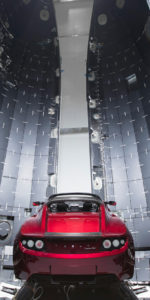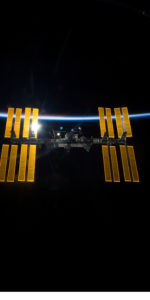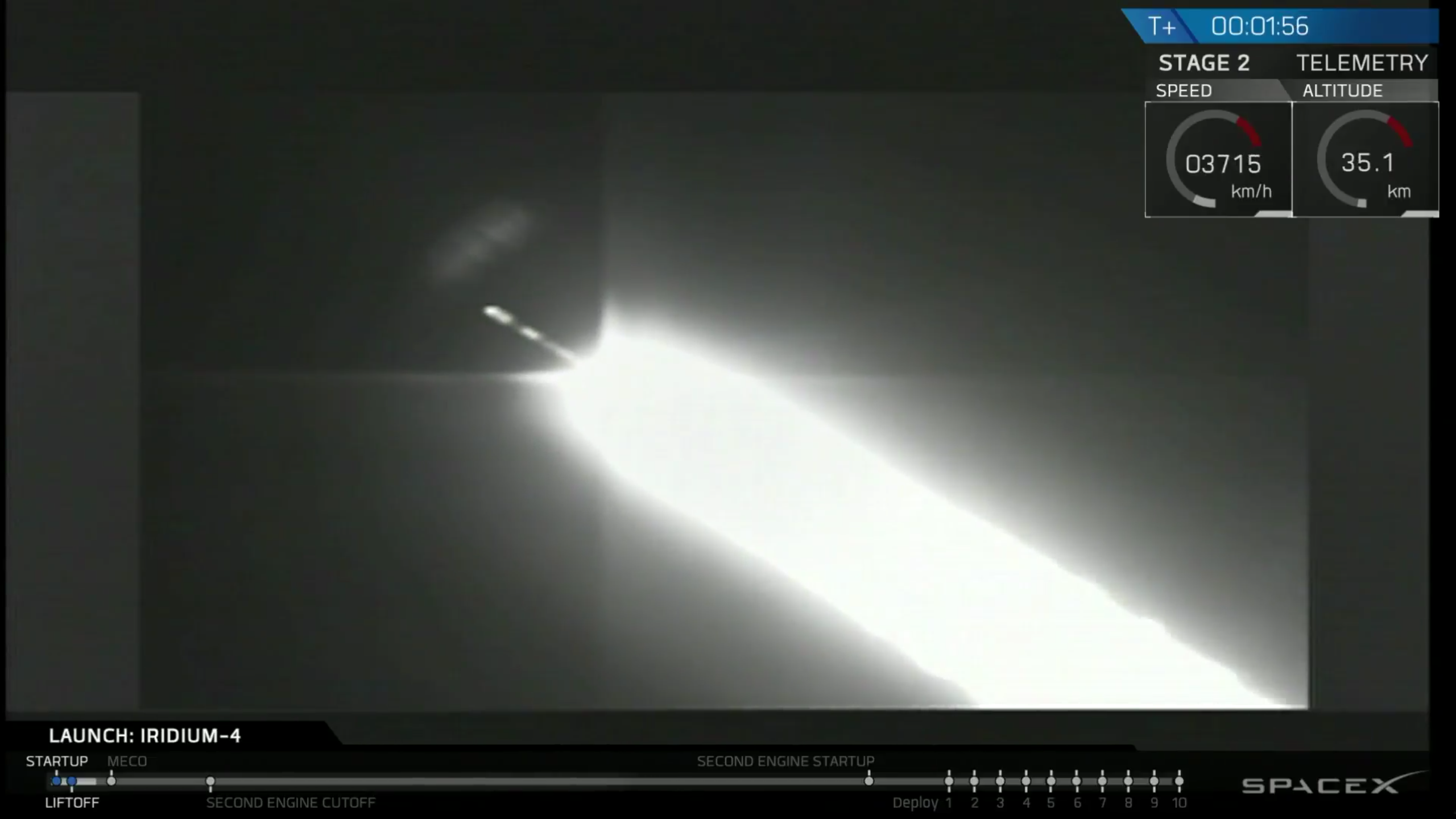
SpaceX has closed out 2017 with a personal-best-beating 18th launch, more than twice as many as it has ever previously achieved in a single calendar year. Its 230-foot-tall (70-meter) Upgraded Falcon 9 booster rose majestically from Space Launch Complex (SLC)-4E at Vandenberg Air Force Base, Calif., during an “instantaneous” window at 5:27:23 p.m. PST on Friday, 22 December. Primary payload for the mission was the fourth “batch” of ten Iridium NEXT global mobile telecommunications satellites, which SpaceX delivered successfully into low-Earth orbit. Tonight’s launch brings to 40 the total number of Iridium NEXT birds orbited in 2017 and represents more than half of the 75 overall satellites which are slated to be lofted by SpaceX by next summer.
Eighteen launches in a single calendar year is remarkable and represents more than twice as many flights as has even been accomplished by SpaceX. Last year’s total saw eight Falcons launched successfully from Vandenberg and Cape Canaveral Air Force Station, Fla., not counting the 1 September on-the-pad loss of the Amos-6 vehicle. Previous years peaked at six successful flights. Recent remarks by SpaceX President Gwynne Shotwell have indicated plans to fly many more times in 2018, with an expectation that the Hawthorne, Calif.-headquartered organization could “level-out” at 30-40 launches per annum, representing a flight every ten days or so.

Indeed, 2017 has been a banner year for SpaceX, having seen the long-awaited inauguration of historic Pad 39A at the Kennedy Space Center (KSC) for SpaceX operations, as well as its first classified payload for the National Reconnaissance Office (NRO), its first reused Upgraded Falcon 9 first stage and its first reused Dragon cargo vehicle. Including tonight’s mission, the year ends for SpaceX with no less than 54 major payloads having been transported aloft, seven of which headed for 22,300-mile-high (35,800) geostationary orbit. Forty-six others—including 40 Iridium NEXT satellites, spread across launches in January, June, October and tonight—have entered low-Earth orbit, with Taiwan’s Formosat-5 lofted into a near-polar, Sun-synchronous orbit in August for intensive observations of the Home Planet. Added to the tally have been four Dragon cargo ships to the International Space Station (ISS), the greatest number ever launched in a single year.
Back in October, it was announced that the next two Iridium NEXT batches would both fly aboard re-used Upgraded Falcon 9 first stages. This makes Iridium the first company in history to re-use the same rocket to launch its own spacecraft. “I believe that reusability is the future for satellite launches and I think SpaceX has intelligently built their Falcon 9 program around this strategy,” said Iridium CEO Matt Desch. “With three successful flight-proven Falcon 9 launches already this year, we’re excited to show leadership towards the sustainable access to space, whilst also making sure we maintain our cadence to complete the five remaining Iridium NEXT launches by the middle of next year.” It was noted at the time that the use of flight-proven first stages would generate no increased premiums and create no changes to in-place risk profiles, as confirmed between Iridium and its insurers.
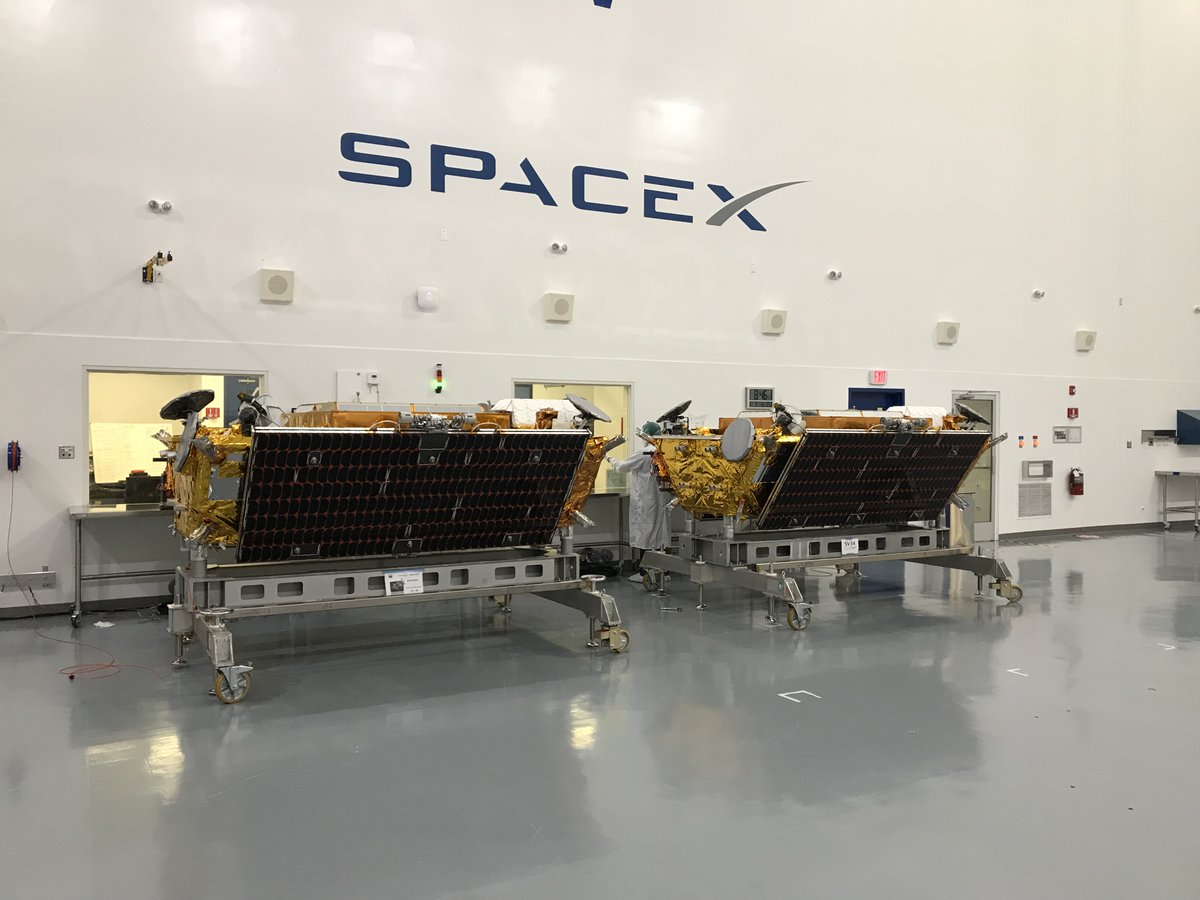
Contracts between SpaceX and Iridium for this ambitious campaign were inked way back in June 2010 and, at the time, represented the largest single launch deal ever signed, worth an estimated $492 million. Over the coming months, Iridium NEXT will completely replace its aging network of first-generation satellites, whose earliest members were launched two decades ago. Iridium NEXT is being overseen by prime contractor Thales Alenia Space, with its subcontractor Orbital ATK selected to build the operational satellites, together with on-orbit and ground-based spares.
Each Iridium NEXT bird is based upon the Extended LifeTime Bus (EliTeBus)-1000 spacecraft, which previously saw service for the low-orbiting GlobalStar communications satellites. Weighing around 1,760 pounds (800 kg), they are powered by twin solar arrays and operate at a mean altitude of 485 miles (780 km), inclined 86.4 degrees to the equator, having the capability of a decade-long lifespan. Their solar arrays, when fully unfurled on-orbit, span 31 feet (9.4 meters) and generate two kilowatts of electricity, a 50-percent uplift over the power-producing potential of the first-generation Iridiums.
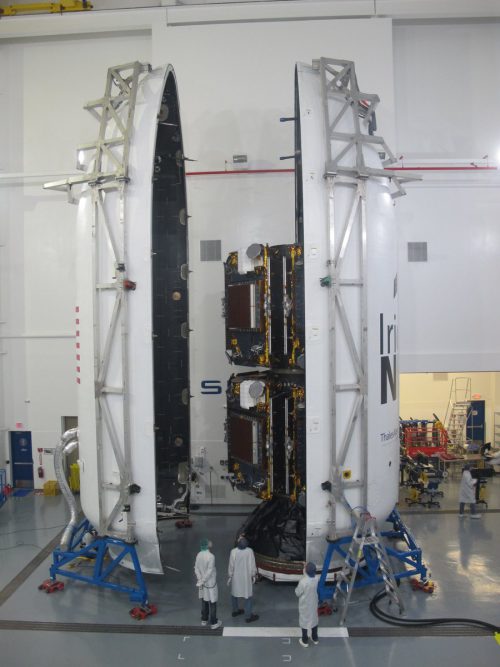
Under the original contract, SpaceX was expected to deliver 70 Iridium NEXT satellites into orbit, over seven missions, but in January 2017 it was announced that it would benefit from a “rideshare” arrangement, flying an additional five “spares” on an eighth Upgraded Falcon 9. This additional mission, presently targeted to launch in March 2018, will also carry NASA’s Gravity Recovery and Climate Experiment Follow-On (GRACE-FO) mission. Two other Iridium NEXT satellites are expected to launch atop a silo-launched Dnepr rocket, courtesy of Moscow-based International Space Company (ISC) Kosmotras, although this mission is expected to occur further downstream.
According to Mr. Desch, the NEXT constellation is already supporting the on-orbit testing of the new Iridium Certus broadband service, which provides safety and critical L-band communications connectivity and promises speeds as high as 1.4 Mbps. Iridium expects Certus to be active on all of its NEXT satellites by next summer. “Iridium Certus is going to fundamentally change the status quo in satellite connectivity for aviation, maritime, land-mobile, Internet of Things (IoT) and government users,” explained Mr. Desch in an Iridium news release. “Achieving this major milestone continues our momentum for our mission to introduce world-changing broadband services and applications designed to help our partners provide critical connectivity solutions, both standalone and in support of other broadband technologies.”
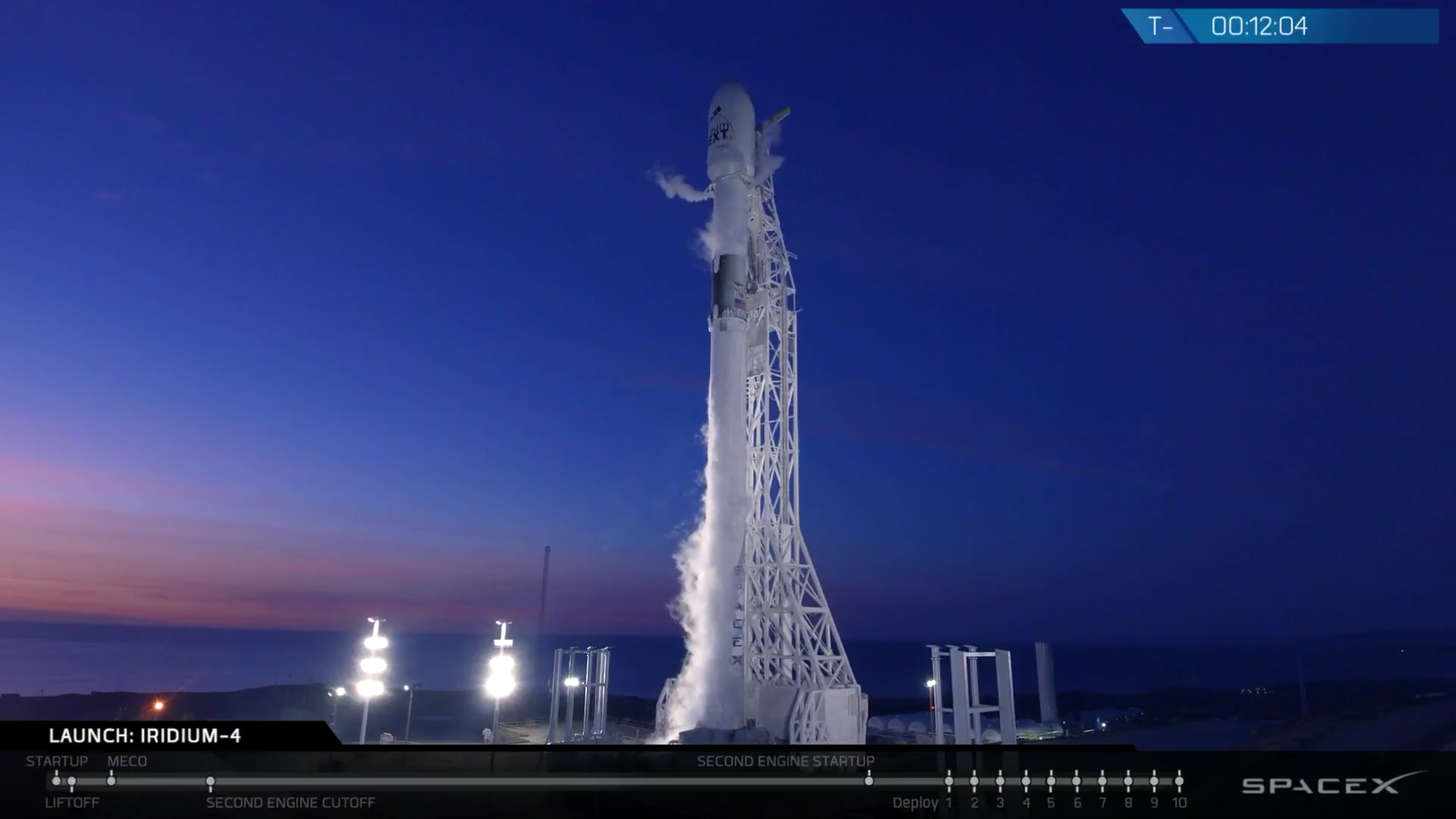
The first ten Iridium NEXT birds were launched out of Vandenberg on 14 January 2017, followed by a second batch on 25 June and a third set on 9 October. A month later, Mr. Desch tweeted that efforts to send the fourth group of satellites out to Vandenberg was well underway, with the first pair of satellites having left the factory on 7 November. “First stage and dispenser on-site,” he noted on the 10th, referring to the core of the Upgraded Falcon 9 and the SpaceX-built payload dispenser which will accommodate the ten satellites. “2018 schedule firming up too…Halfway home!” The satellites were shipped two at a time, crated in motion- and temperature-controlled containers to maintain optimal environmental conditions, with the ninth and tenth members arriving at Vandenberg on 28 November.
They were mounted onto their dispenser, fueled and finally encapsulated within the Upgraded Falcon 9 payload fairing on 12 December. “We’re approaching our halfway point on this journey and with each launch we gain more momentum,” said Mr. Desch. “This launch will bring us to 40 Iridium NEXT satellites in space, which is more than half the number required for a full Iridium NEXT operational constellation. It has been remarkable to witness the increased speed, capacity and throughput of our network, as we continue to replace our original satellites with new Iridium NEXT satellites.” In a 12 December tweet, he added that he was “keeping an eye” on the ongoing California wildfires, “but so far not looking like a problem” for the launch.
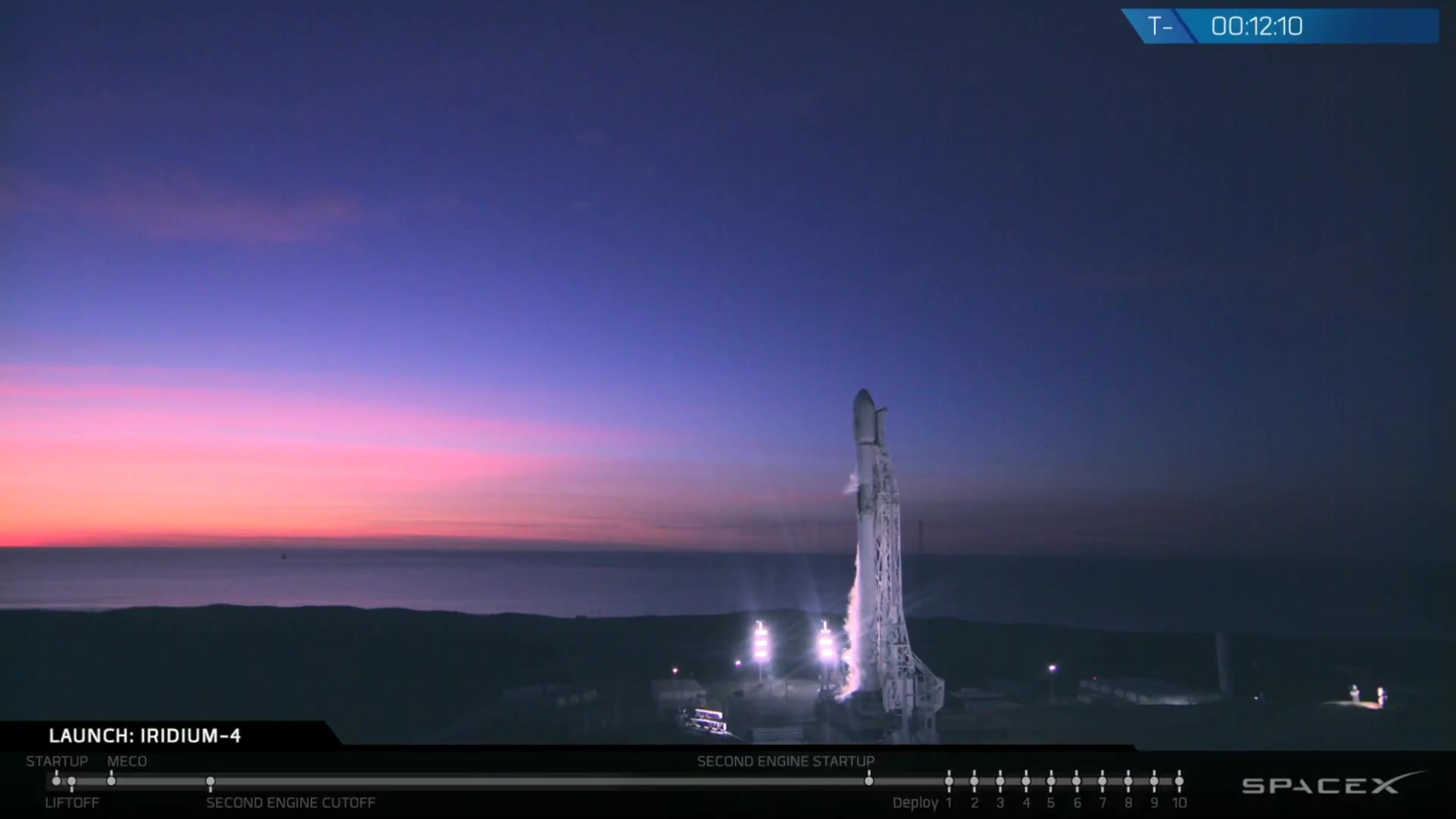
Tonight’s flight represented the fifth mission—and the second occasion in just one week—to sport a “re-used” Upgraded Falcon 9 first stage; in this case, the booster had previously seen service to deliver the second batch of Iridium NEXT satellites into orbit, back on 25 June. All told, the payload mass, including the ten satellites and their dispenser, totaled 21,160 pounds (9,600 kg). However, tonight’s re-used booster will not see another flight, for its second flight is not equipped with landing legs and is intended to be expendable.
Following a customary Static Fire Test of the nine Merlin 1D+ engines on the rocket’s first stage on Sunday, 17 December, the pieces were set for Friday night’s launch of the final SpaceX mission of 2017. In the aftermath of the test, the booster was returned to a horizontal configuration and taken back to the assembly building, where the bullet-like payload fairing was installed. The 230-foot-tall (70-meter) Upgraded Falcon 9 was confirmed vertical on SLC-4E late on the evening of Thursday, 21 December, for the “instantaneous” launch window. “We went vertical about 8 p.m.,” noted Mr. Desch, “and everything looks good for tonight’s launch.”
Loading of the booster with liquid oxygen and a highly refined form of rocket-grade kerosene, known as “RP-1”, got underway in the mid-afternoon. At 5:17 p.m. PST, as the countdown passed T-10 minutes, the terminal autosequencer was initiated and the nine first-stage engines were chilled down, ahead of the ignition sequence. At T-2 minutes, the Air Force Range Safety Officer verified that all ground-side assets were “Go for Launch” and the vehicle transitioned to Internal Power and assumed primary command of all critical functions, entering “Startup” at T-1 minute. At this point, the Niagara deluge system began flooding the surface of SLC-4E with 30,000 gallons (113,500 liters) of water, per minute, to suppress the acoustic energy at liftoff.
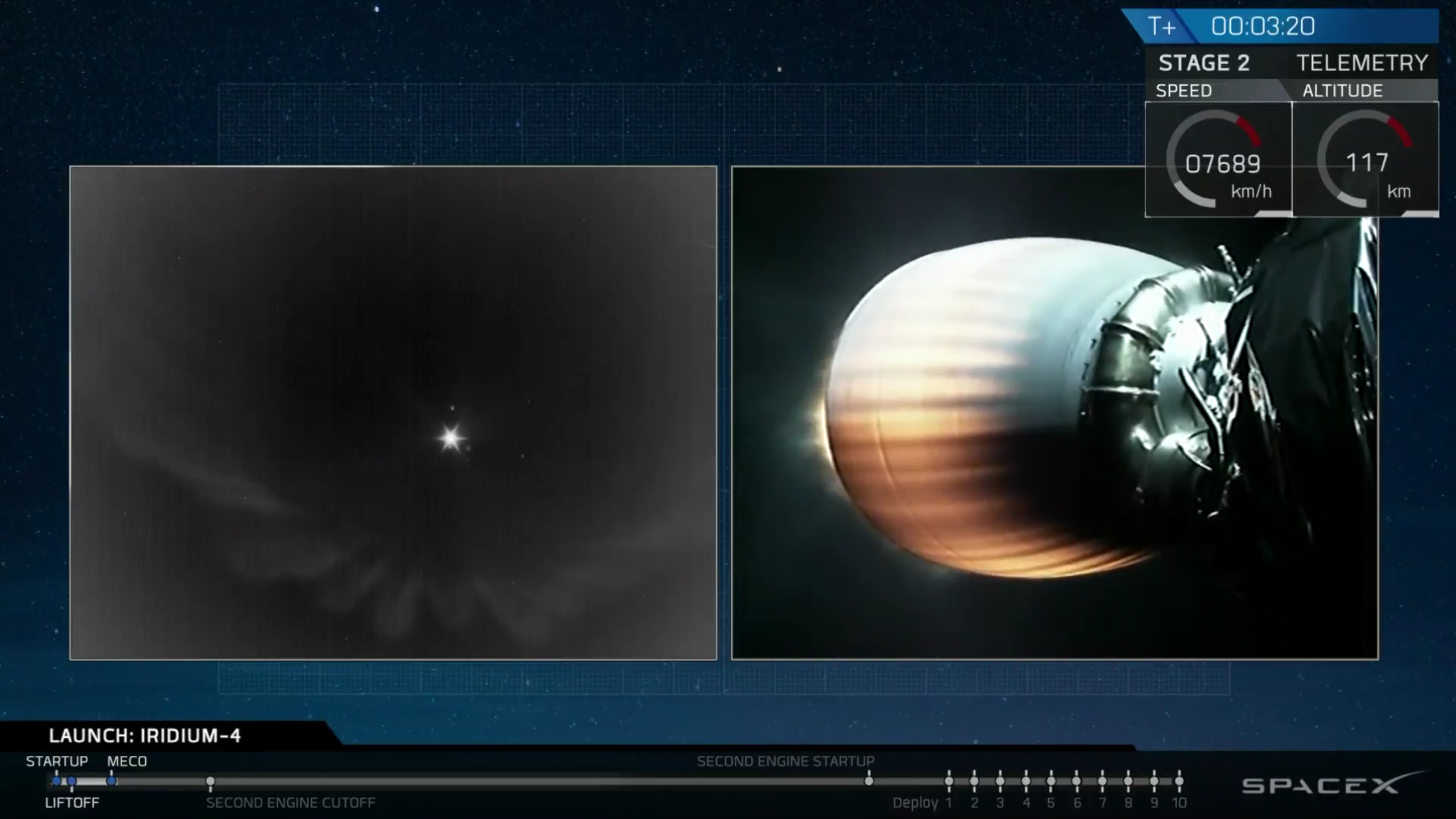
At T-3 seconds, the nine Merlins thundered to life, ramping up to a combined thrust of 1.5 million pounds (680,000 kg). Liftoff occurred precisely on time at 5:27:23 p.m. PST and the vehicle followed a perfect ascent trajectory into the gathering darkness, its first stage providing the muscle for the first 2.5 minutes, before separating. In the meantime, with the first stage gone, the Merlin 1D+ Vacuum engine of the second stage ignited for the first of two “burns” to inject the ten Iridium NEXT satellites into their proscribed orbits. Generating 210,000 pounds (95,250 kg) of thrust, the engine performed with perfection. Its first burn lasted 6.5 minutes, with the engine shutting down a little over nine minutes after departing Vandenberg. At this point, the vehicle entered a prolonged period of “coasting”, lasting almost 43 minutes, until the Merlin 1D+ Vacuum was re-lit for a few seconds to position the satellite group for deployment.
Fifty-two minutes after leaving SLC-4E, the second stage fell silent, as planned, allowing the 15-minute deployment to proceed. A little over an hour into the mission, all ten Iridium NEXT birds had been released from their dispenser and SpaceX has now transported 53 percent of its 75-strong tally of satellites to orbit. Current plans call for further batches of ten to fly in February, June and August 2018, with the rideshare mission of five Iridium NEXT satellites and GRACE-FO targeted for launch in late March.
FOLLOW AmericaSpace on Facebook!
.




